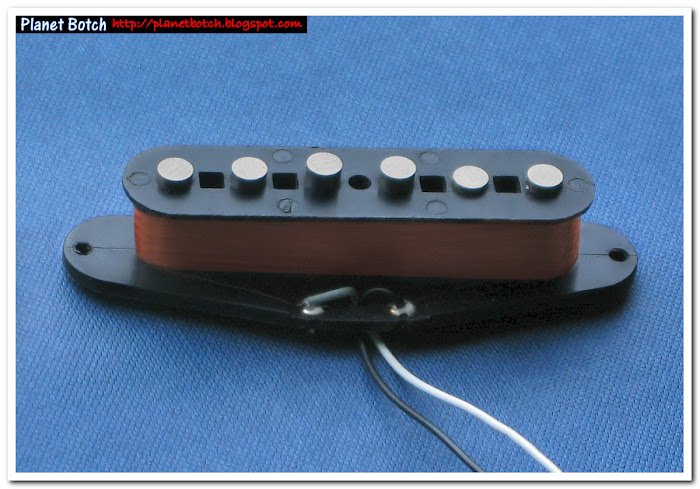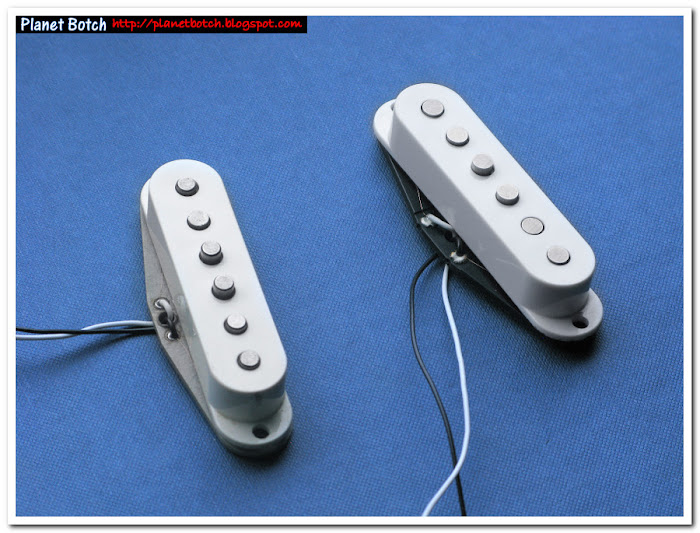The earliest ’57 and ’62 Stratocaster reissues from Fender Japan featured pickups which pretty accurately followed the vintage spec. But as those initial MIJs were starting to emerge in the early 1980s, the standard (non-vintage) American models were already carrying a more practical pickup with a one-piece moulded plastic bobbin, and these new-style units made a lot more sense on the production line. Cheap to make, properly insulated to avoid the centre of the coil shorting out against the magnets... Moulded plastic bobbins were the way forward.
The prospect of switching authentic vintage fibre top and bottom plates for the new plastic moulded bobbin on mid-range reissues, as a money-saving measure alone, must have been a consideration early on. And indeed it didn’t take too long for budget and practicality to oust authenticity. By the mid ‘80s, the popular Fender Japan ’57 and ’62 reissues were carrying an adaptation of the early ‘80s American ‘standard’ pickup. Plastic bobbins, plastic link-up wire, and a slightly pinkish coppery coil, wound tight, with no wax-potting. In fact, the only fundamental difference between the new Japanese ‘vintage reissue’ pickup and the early ‘80s American ‘standard’ pickup, was the length of the poles. On the MIJ reissues, the poles were staggered; on the early ‘80s US Strats they were flush.

Above you can see the main features of the MIJ reissue pickup as fitted to ’57 and ’62 Strat replicas from the mid ‘80s onward. Just like on a vintage Strat, the pole-pieces are made from alnico V. But apart from that, the construction is a major departure. The cavities between the poles run right through the bobbin from top to bottom, saving on plastic. You can see how the plastic bobbin would look without the coil in this article on Strat pickups.
SOUND
These moulded MIJ staggered Strat pickups didn’t of course sound exactly like the original vintage units of the ‘50s and ‘60s, but they weren’t very far wide of the mark at all. They had more upper midrange kick than the polite and glassy rival VI pickups from Tokai, which featured traditional fibre construction. To my ears, the Fenders’ upper mid bite was more in keeping with the vintage tone than the Tokais’ hi-fi clunk. The Tokai VIs were nice, very well made and convincing to look at, but they sounded more like ‘70s pickups than ‘60s pickups to me.
Admittedly, a strong upper mid bite was a bit much on a brand new Strat. It rendered the Japanese Fenders a bit light on bass and slightly nasal in tonality. But actually, real vintage Strats have that same mildly nasal quality in the pickups. It’s just that the ageing process balances things up, adds bottom end and rolls off some of the more vicious treble. You’re left with the character – the punch, but not the imbalance. The ‘80s MIJ Strat reissues, with their one-piece pickups, needed a few years’ playing in (and normally some extra compensation from the amp tone controls in the beginning), but they had that notorious poke and energy. The pickups may not have been great to look at, but they had the right tonal nuances, and unlike numerous other vintage reissue units, they had the characteristic excitement and attack.

Above you can see that even with the covers on, the difference between the Tokai VI Staggered Strat pickup (left) and the Fender one-piece MIJ Staggered Strat is pretty clearly apparent. The Fender has wider pole-pieces with no chamfer. The Tokai has a heavy chamfer and narrower poles. You can also see that the Tokai VI’s fibre bottom plate is light grey (as is the top plate). This accurately simulated the colouring of a mid '60s Strat pickup. The link-up wire on the Tokai pickup has been replaced. It was originally a rather synthetic looking cloth-covered wire.
Even through into the mid 1990s, the one-piece staggered alnico Strat pickups fitted to Fender Japan's '57 and '62 reissues remained full of vitality. Only when alnico staggered poles were dropped in 1995 did things take a turn for the worse and at that point, the guitars instantly lost their tonal appeal.
On paper, the rather grim looking pre-'95 Fender Japan staggered alnicos shouldn't have worked. They had the wrong type of construction, the wrong coil wire, and the inner coil was the wrong distance from the magnets. But work they did, and I'm sure I wasn't the only one over the years who replaced a set of these with something much more expensive, only to prefer the plastic Fender 'cheapies' and put them back in. There were better Strat pickups available, obviously, but not all flashy alternatives had the edge on these cheeky little monkeys!
More Strat Articles

